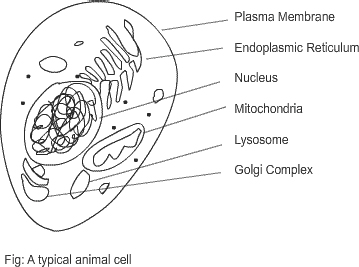Exploring the Building Blocks of Life: An Introduction to Cells
Classified in Biology
Written on in  English with a size of 3.21 KB
English with a size of 3.21 KB
The Discovery of Cells
a) In 1655, scientist Robert Hooke made an observation while examining a dried section of cork tree with a crude light microscope. He observed small chambers and named them "cells."
What are Cells?
b) The cell is known as the basic structural and functional unit of life, as all organisms are composed of cells.
c) Single-celled organisms are called unicellular (e.g., amoeba), while those having more than one cell are called multicellular.
Functions of Cells
d) All basic chemical and physiological functions of living beings - for example, repair, growth, movement, immunity, communication, and digestion - are carried out inside the cells.
Structure of a Cell
e) Cells are mostly round, spherical, or elongated. Some cells are quite long. Some are branched, like the nerve cell or a neuron. Components of the cell are enclosed in a membrane, which provides shape to the cells. A cell wall is an additional covering over the cell membrane to give shape and rigidity to plant cells.

f) The nerve cell receives and transfers messages, thereby helping to control and coordinate the working of different parts of the body.
g) The cell membrane functions as a semi-permeable membrane that allows the transmission of a few molecules across it. It gives shape to the cell. The plasma membrane is porous and allows the movement of substances or materials in and out of the cell.
h) Cytoplasm is the jelly-like substance present between the cell membrane and the nucleus. Various cell organelles are present in the cytoplasm, such as mitochondria, Golgi bodies, and ribosomes.
i) The nucleus is generally a spherical body located in the center of the cell. It can be stained and seen easily with the help of a microscope. It acts as a control center for all the activities of a cell. The nucleus is separated from the cytoplasm by a membrane called the nuclear membrane. This membrane also allows the movement of materials between the cytoplasm and nucleus.
j) The entire content of living cells, including the cytoplasm and nucleus, is known as protoplasm.
k) Vacuoles are fluid-filled structures surrounded by a membrane. Plant cells have vacuoles that are very large in size.
Plant Cells vs. Animal Cells
l) Plant cells have a cell wall, while animal cells only have a cell membrane. Plant cells contain chloroplasts, which are used for photosynthesis. Plant cells have a large vacuole compared to an animal cell.
m) In green plant parts like leaves, plastids contain a green pigment called chlorophyll. Chlorophyll-containing plastids are called chloroplasts and provide a green color to the leaves. Chlorophyll is essential for the process of photosynthesis.
